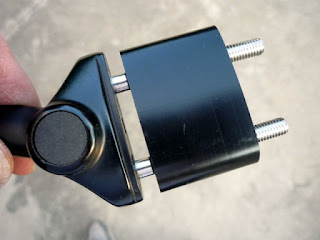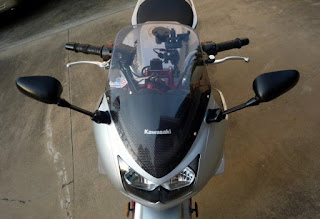For any of you who ride a sportbike, the rear view mirrors are many times not very effective. My Kawasaki Ninja 650R has this problem: I can see my arms pretty well, up close on the sides, and a little of what is behind me, but that is not really sufficient.
There are a few fixes to this problem, including installing mirrors on the controls like a Kawasaki Versys,
adding a bar-end mirror,
putting in a hinge extender available from Twisted Throttle,
or putting a spacer between the factory mirror mounting location and the mirror base.
The stalks of the first option may be effective, but they don't look so good on a sportier bike, and they would interfere with my Hippo Hands or the Ducks Unlimited hand warmers The bar-end mirrors might be better, but the Hippo Hands are similarly in the way, and the bar weights would have to be turned down or removed to mount this style mirror. The hinge extender works well, but it costs north of $70.00.
I chose the last alternative, the spacer at the base, because it preserves the original look and costs less, at around $43 including shipping.
I looked through ebay to see what I could find. Seller rrbarna in Canada lists spacers for several bikes, one of which is the 650R. Buy-it-now set the transaction in motion. Gotta love ebay.
A little while later, I received an e-mail saying they were out of stock in the U.S., but that they would send them from their manufacturing facility in Hungary. Yes, Hungary, over there in the former eastern Europe. I had concerns. Despite the shipping distance, they arrived in about a week.
The spacers are nicely CNC machined from solid black, hard, slippery plastic. The color matches the mirrors nicely. They come with four stainless steel extension studs, so the original nuts can secure them to the instrument stay from beneath the cowlings.
Although there were no instructions, I managed to figure out how to put them on. That engineering degree has come in handy a number of times, now!
The most direct route to reach the nuts would be to remove the windscreen, the instrument surround, and some other plastic. Instead, I elected to try to reach up under the cowlings above the front wheel with my 1/4" ratchet and 10mm deep socket. I had to do this by Braille because you cannot see the nuts from anywhere I could find down there. Also, you have to be ambidextrous, since you must reach in with your right arm to reach the right mirror and the opposite for the left.
After some fumbling, I was able to get the mirrors off. I threaded the extension studs onto the existing ones and tightened them snugly. Then I slipped the plastic spacers over the studs, matching the contour of the spacer to that of the base of the mirror, and reversed the removal process to reattach them.
The mirrors will be spaced out 1-3/8" further than stock.
This was easier said than done. Working blind, and trying to thread the nuts onto the studs was a challenge. Nevertheless, the method worked and I lived to tell about it, with some cuts and abrasions and a little dirt to mark my battle.
Don't worry, I'll live. The sacrifices we make for our scooters!
The finished product, just before a test ride.
Proper adjustment of the mirrors on a bike is vital. It is not as important to see directly behind you as it is to see vehicles to the sides. Of course, lane changing relies both on the image in the mirrors and on a head check. Scanning for other traffic is also critical so you can react should there be a need. This includes behind us, to the sides, as well as in front.
I have my mirrors set so I can just barely see the bar-end weights in the lower inside corner of the mirrors for reference. The rest of the view is of the adjacent road. I also position them so they are not pointing down at the road or up into the sky. This gives me a wider view of what is going on behind me.
A head check (looking to the side and partially behind you by turning your head) is difficult to perform for some people, and you must look rather than use your peripheral vision to check what is around you or where you are about to go. One trick I have learned is to swing my head down and toward the rear. That technique gives me more visible area directly behind me. I also find this method faster and easier on the neck, and reduces the need to twist the shoulders and the resulting effect on the handlebar position.
When I first got this bike, I was surprised to find that the rear view mirrors are convex, giving a wider view, but making the objects in the mirrors seem closer than they actually are. I couldn't find any reference to this fact in the literature I received with the bike.
[Well, how's the mirror image, Bucky?]
Oh, yes. I took a short ride to get the mirrors adjusted properly, and I think the mirror extenders are a good solution to the limited view offered by the original Ninja 650R mirrors. I can now see further behind me to the sides, so that the mirrors, plus head checking, plus peripheral vision covers all of the area I should see. It is much better than before.
What is your solution to this issue?
.

.














No comments:
Post a Comment